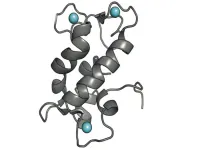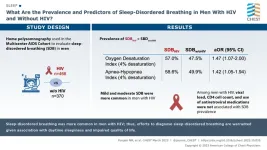(Press-News.org) UNIVERSITY PARK, Pa. — A new biosensor engineered by Penn State researchers offers scientists the first dynamic glimpses of manganese, an elusive metal ion that is essential for life.
The researchers engineered the sensor from a natural protein called lanmodulin, which binds rare earth elements with high selectivity and was discovered 5 years ago by some of the Penn State researchers involved in the present study.
They were able to genetically reprogram the protein to favor manganese over other common transition metals like iron and copper, which defies the trends observed with most transition metal-binding molecules.
The sensor could have broad applications in biotechnology to advance understanding of photosynthesis, host-pathogen interactions and neurobiology. It could also be potentially applied more generally for processes such as separation of the transition metal components (manganese, cobalt, and nickel) in lithium-ion battery recycling.
The team recently published their findings in the Proceedings of the National Academy of Sciences.
“We believe that this is the first sensor that is selective enough for manganese for detailed studies of this metal in biological systems,” said Jennifer Park, a graduate student at Penn State and lead author on the paper. “We’ve used it — and seen the dynamics of how manganese comes and goes in a living system, which hasn’t been possible before.”
She explained that the team was able to monitor the behavior of manganese within bacteria and are now working to engineer even tighter binding sensors to potentially study how the metal works in mammalian systems.
Like iron, copper and zinc, manganese is an essential metal for plants and animals. Its function is to activate enzymes — molecules with vital jobs within living systems. For example, manganese is a key component of the photosynthetic process in plants — manganese is present at the site where water is converted to oxygen that is at the heart of photosynthesis. In humans, manganese is linked to neural development. Accumulation of excess manganese in the brain induces Parkinsonian-like motor disease, whereas reduced manganese levels have been observed in association with Huntington’s disease, the researchers explained.
However, scientific understanding of manganese has lagged behind that of other essential metals, in part because of a lack of techniques to visualize its concentration, localization and movement within cells. The new sensor opens the door for all kinds of new research, explained Joseph Cotruvo, associate professor of chemistry at Penn State and senior author on the paper.
“There are so many potential applications for this sensor,” said Cotruvo. “Personally, I am particularly interested in seeing how manganese interacts with pathogens.”
He explained that the body works hard to restrict the iron that most bacterial pathogens need for survival, and so those pathogens instead turn to manganese.
“We know there is this tug-of-war for vital metals between the immune system and these invading pathogens, but we haven’t been able to fully understand these dynamics, because we couldn’t see them in real time,” he said, adding that with new capabilities to visualize the process, researchers have tools to potentially develop new drug targets for a range of infections for which resistance has emerged to common antibiotics, like staph (MRSA).
Designing proteins to bind to particular metals is an intrinsically difficult problem, Cotruvo explained, because there are so many similarities between the transition metals present in cells. As a result, there has been a lack of chemical biology tools with which to study manganese physiology in live cells.
“The question for us was, can we engineer a protein to only bind to one thing, a manganese ion, even in the presence of a huge excess of other very similar-looking things, like calcium, magnesium, iron, and zinc ions?” Cotruvo said. “What we had to do was create a binding site arranged in just the right way, so that this protein bond was more stable in manganese than any other metal.”
Having successfully demonstrated lanmodulin is capable of such a task, the team is now planning to use it as a scaffold from which to evolve other types of biological tools for sensing and recovering many different metal ions that have biological and technological importance.
“If you can figure out ways of discriminating between very similar metals, that's really powerful,” said Cotruvo. “If we can take lanmodulin and turn it into a manganese-binding protein, then what else can we do?”
Other co-authors on the paper are Joseph Mattocks and Jiansong Xu of Penn State; Michael Cleary, Huan Wang and Eric Gale, of Massachusetts General Hospital and Harvard Medical School; and Danyang Li and Somshuvra Mukhopadhyay of The University of Texas at Austin.
The National Institutes of Health and start-up funding from Penn State supported this work.
END
New biosensor reveals activity of elusive metal that’s essential for life
2023-03-09
ELSE PRESS RELEASES FROM THIS DATE:
Deconstructing Lignin
2023-03-09
It’s a tough job, but someone’s got to do it. In this case, the “job” is the breakdown of lignin, the structural biopolymer that gives stems, bark and branches their signature woodiness. One of the most abundant terrestrial polymers on Earth, lignin surrounds valuable plant fibers and other molecules that could be converted into biofuels and other commodity chemicals — if we could only get past that rigid plant cell wall.
Fortunately, the rather laborious process already occurs in the guts of large herbivores through the actions of anaerobic microbes that cows, goats and sheep rely on to release the nutrients ...
People don’t know what a preprint is. Here’s why that matters
2023-03-09
New research from the University of Georgia suggests most people don’t understand the difference between a preprint and a published academic journal article.
Preprints are research papers that haven’t undergone peer review, the process by which studies’ findings are validated by experts who weren’t involved with the research themselves.
The study found the majority of readers have little to no understanding of what a preprint actually is. That lack of understanding could lead to public distrust in science since findings and how those findings are described can change between the preprint phase and ...
Ontario sees big jump in amphetamine-related emergency visits
2023-03-09
Ontario’s emergency departments are seeing a dramatic rise in visits related to the use of unregulated amphetamines and their street equivalent: crystal meth.
In a new paper published in the Canadian Journal of Psychiatry, researchers found that individuals accessing the emergency department (ED) for amphetamine- and methamphetamine-related concerns grew from 233 in 2003 to 4,146 individuals annually by 2020.
“That’s a nearly 15-fold increase – pretty dramatic. If we consider ED visits as a crude proxy for how prevalent unregulated amphetamine use is, then the observed trend is highly concerning,” said the paper’s lead author, ...
Highlights from the journal CHEST®, March 2023
2023-03-09
Glenview, Illinois – Published monthly, the journal CHEST® features peer-reviewed, cutting-edge original research in chest medicine: Pulmonary, critical care and sleep medicine and related disciplines. Journal topics include asthma, chest infections, COPD, critical care, diffuse lung disease, education and clinical practice, pulmonary vascular disease, sleep, thoracic oncology and the humanities.
The March issue of the CHEST journal contains 44 articles, including clinically relevant research, reviews, case series, commentary and more. Each month, the journal also offers complementary ...
Nutrition educators support nutrition incentives for food and nutrition security programs to promote increased intake of fruit and vegetables
2023-03-09
Philadelphia, March 9, 2023 – The Gus Schumacher Nutrition Incentive Program (GusNIP), funded by the U.S. Department of Agriculture, includes Nutrition Incentive (NI) and Produce Prescription (PPR) programs. These programs provide financial incentives for healthy eating by increasing individuals’ purchase and consumption of fruits and vegetables and reducing food insecurity in order to prevent and treat nutrition-related diseases. A study in the Journal of Nutrition Education and Behavior, published by Elsevier, explores how nutrition educators work with NI and PPR programs ...
Diverse approach key to carbon removal
2023-03-09
RICHLAND, Wash.—Diversification reduces risk. That’s the spirit of one key takeaway from a new study led by scientists at the Department of Energy’s Pacific Northwest National Laboratory. The effective path to limiting global warming to 1.5 degrees Celsius by the end of this century likely requires a mix of technologies that can pull carbon dioxide from Earth’s atmosphere and oceans.
Overreliance on any one carbon removal method may bring undue risk, the authors caution. And we’ll likely need them all to remove the necessary amount ...
New class of drugs may prevent infection by wide range of COVID-19 variants
2023-03-09
Study Title: Pharmacologic disruption of mSWI/SNF complex activity restricts SARS-CoV-2 infection
Publication: Nature Genetics https://www.nature.com/articles/s41588-023-01307-z
Dana-Farber Cancer Institute author: Cigall Kadoch, PhD
Summary:
A new class of oral drugs can inhibit a wide range of SARS-CoV-2 variants, researchers report, potentially identifying new antiviral agents providing broad activity against the constantly emerging new strains of the COVID-19 virus. The researchers discovered that the mammalian SWI/SNF (also called BAF) chromatin remodeling complex, a regulator of gene expression –controls the expression of the ACE2, the ...
MSU research reveals how climate change threatens Asia’s water tower
2023-03-09
EAST LANSING, Mich. – Tibet is known as the “Water Tower of Asia,” providing water to about 2 billion people and supporting critical ecosystems in High Mountain Asia and the Tibetan Plateau, where many of the largest Asian river systems originate. This region is also one of the areas most vulnerable to the compounding effects of climate change and human activities. Michigan State University researchers are identifying policy changes that need to happen now to prepare for the future impacts projected by climate models.
The rapid melting of glaciers and snowpack due to regional temperature increases has caused ...
Arctic river channels changing due to climate change, scientists discover
2023-03-09
A team of international researchers monitoring the impact of climate change on large rivers in Arctic Canada and Alaska determined that, as the region is sharply warming up, its rivers are not moving as scientists have expected.
Dr. Alessandro Ielpi, an Assistant Professor with UBC Okanagan’s Irving K. Barber Faculty of Science, is a landscape scientist and lead author of a paper published this week in Nature Climate Change. The research, conducted with Dr. Mathieu Lapôtre at Stanford University, along with Dr. Alvise Finotello at the University of Padua in Italy, and Université ...
Mass General Brigham researchers uncover metabolic secrets of anaerobes and identify new strategies to treat c. difficile infections
2023-03-09
A team of investigators from Mass General Brigham’s founding members, Brigham and Women’s Hospital (BWH) and Massachusetts General Hospital (MGH), has identified metabolic strategies used by Clostridioides difficile to rapidly colonize the gut. The findings identify methods to better prevent and treat the most common cause of antibiotic-associated diarrhea and healthcare-acquired infections (HAIs). The team’s approach has implications for understanding broader aspects of microbial metabolism, including responses to antibiotics, and production of important metabolites. Results are published ...






